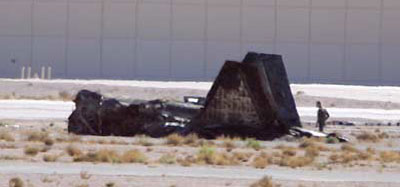
F-22-Raptor - $$3.95
The Lockheed Martin/Boeing F-22 Raptor known in the 90s as the Lightning II is a fifth-generation, fighter aircraft that uses stealth technology. It is primarily an air superiority fighter, but has multiple capabilities that include ground attack, electronic warfare, and signals intelligence roles.
F-22 Raptor - Next Generation Stealth ATF US Fighter
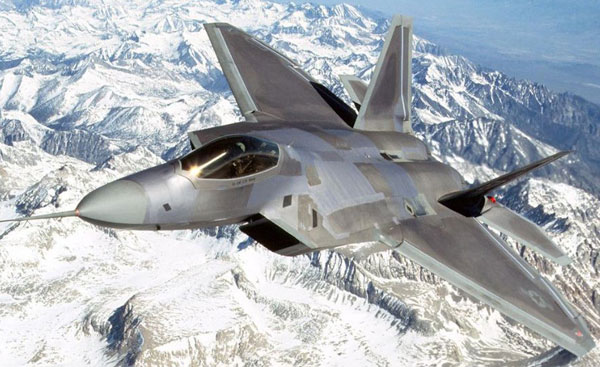
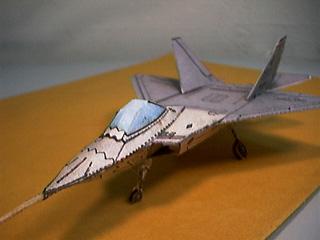
F-22 Stealthy 'Raptor' is the ATF US fighter of the 21st century. A 'cold war casualty, the funding of this aircraft is now being challenged but aviation experts tend to agree that it'll be produced.
F-15 Eagles may have proved themselves well in the Gulf War, but
the simple fact remains: that the aircraft is getting old, while
Soviet fighters have begun surpass Western types in terms of maneuverability
and performance.
To address these problems, and to maintain the US
edge in systems technology, the US Air Force is looking to procure
an Advanced Tactical Fighter.
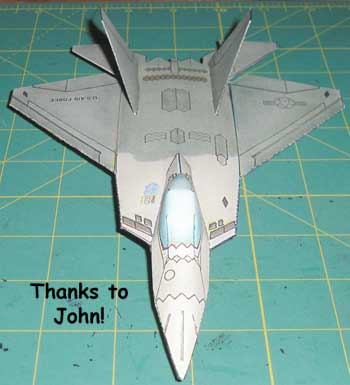
F-22 US ATF Stealth Jet Fighter
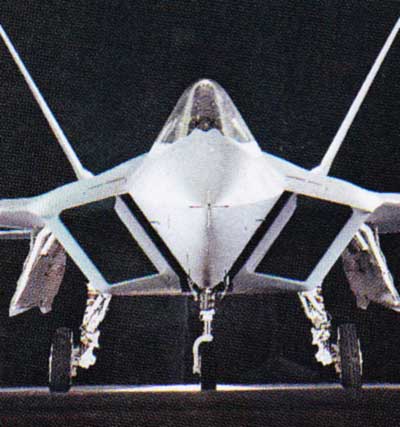
F-15 Eagles may have proved themselves well in the Gulf War, but the simple fact remains: that the aircraft is getting old, while Soviet fighters have begun surpass Western types in terms of maneuverability and performance. To redress these problems and to maintain the US edge in systems technology, the US Air Force is looking to procure an Advanced Tactical Fighter. Here we analyze the two competing designs.
Experience in the Vietnam War graphically showed the shortcomings of US fighters when faced with manoeuvrable opposition of supposedly inferior capability. Such experience moved the fighter community back into the traditional world of agility and high performance, producing the F-15, F-16 and F-18. These three types formed the cornerstone of US fighter supremacy through the late 1970s and 1980s, but towards the end of this period, new Soviet fighters began entering service in numbers which threatened the dominance of American designs.
Although of the same generation as the US( types, and in many respects inferior in terms of sophistication, the MiG-29 'Fulcrum' and Su-27 'Flanker' were ahead in basic performance and agility. Reports from the Soviet Union suggested that it would not be long before more advanced follow-on fighters were under development, further threatening the lead of the West.
Thus the Advanced Tactical Fighter program was born in the 1980s, chiefly as a means of providing a replacement for the F-15 Eagle, which had entered service in 1975.
What was required was an aircraft which could rule the skies against any potential threat, unfettered by any air-to-ground considerations. Not only would such an aircraft have to be more powerful and more manoeuvrable than current fighters, it would also need radical improvements to its systems to meet the demands of operations well into the 21st century.
Initial concept definition study contracts were awarded in September 1983 to the main US manufacturers (Boeing, General Dynamics, Grumman, Lockheed, McDonnell Douglas, Northrop and Rockwell). All these companies submitted design proposals on 28 July 1986. On 31 October that year, two were chosen to move to the demonstration/validation phase of the program, these being Lockheed and Northrop. Both companies felt that the program was too large and too important to handle on their own, and selected partners for ATF, although both stayed in overall control.
Under the Dem/Val contract, two PAVs (prototype air vehicles) were to be produced for flight test, together with a ground prototype of the avionics system. Lockheed's aircraft, in conjunction with Boeing and General Dynamics, was to be designated YF-22, while the Northrop/McDonnell Douglas submission was given the YF-23 designation. After some slippage, final proposals for the single Full Scale Development contract were required on 1 January 1991. Throughout the Dem/Val phase, the US Air Force was at pains to emphasize the fact that there was no 'fly-off between the two types, rather a set of tests conducted separately against a standard set of criteria. At the time of writing, the award of the single FSD contract is expected in April1991, leading to 24 FSD aircraft prior to production examples.
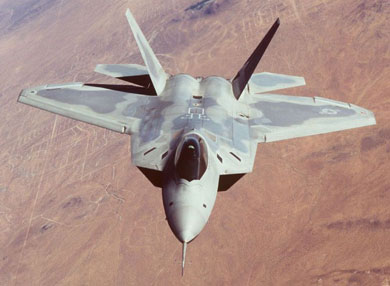
Northrop/McDonnell Douglas scored the first point by revealing their YF-23 first, on 22 June 1990, and at once the considerable advances being made by these aircraft became immediately apparent. The YF-23 (unofficially called the 'Black Widow') looked like no other aircraft, although some resemblances to the Lockheed SR-71 and the mythical 'Fire fox', from the Clint Eastwood movie of the same name, were noted. The airframe in profile is long and sinuous. A forward fuselage body blends into the central structure, while two large overawing bulges contain the engines. Underneath the leading edge are the engine intakes, leading to serpentine trunks which sweep the air upwards and inwards to the engines.
Exhaust from the engines is emitted from long, rectangular intakes mounted above and inboard from the leading edge. Surprisingly thrust-vectoring was not included at the final design stage: what had once been a requirement of the US Air Force had been deleted from the design criteria on grounds of acceptable weight. Bays in the lower fuselage, covered by flush-fitting doors, hold the missile armament, comprising four AIM-9 Sidewinders and four medium range missiles, either AIM-7 Sparrow or AIM-120 AMRAAM.
In. plan view the YF-23 is even stranger. Large triangular wings with cut-off tips exhibit the same angle sweep on leading and trailing edge wings. Large tail fins canted at 450 offer considerable area in plan, and join the fuselage at the same point as the trailing edge of the wing. Stealth considerations dictated the now well-known saw tooth arrangement along the trailing edges of the tails and center-body. The forward fuselage has an SR-71-style chine along the side, this forming three distinct angles in plan. This chine forms vortices across the wing, and prevents the nose 'slicing off at high angles of attack. Control surfaces include the all-moving tails, and large ailerons, trailing-and leading-edge flaps. The undercarriage retracts into the engine fairing's to lie beside the intake tanks.
Some time elapsed before the Lockheed team revealed their design, at the Burbank factory on 29 August 1990. A slightly more conventional design, the YF-22 appeared considerably different in many areas, highlighting design concept differences which will be examined later. A stockier design, the profile of the YF-22 is dominated by huge twin fins, canted slightly outwards. The cockpit canopy sits high on the forward fuselage, offering exceptional visibility to the pilot.
In plan the wing is a slightly-swept trapezoidal surface, again with large maneuvering surfaces on the leading and trailing edges (even the flaps aid roll control). An overlapping tailplane is set far back on the aircraft, offering further roll control and exceptional pitch control. However, the Lockheed team took the plunge and incorporated thrust-vectoring. Located between the tailplane's are two saw tooth nozzles with two-dimensional vectoring. Not only does this vastly increase take-off performance, but allows very rapid pitch changes and enables the type to fly very tight sustained turns.
From the front, the YF-22 demonstrates a (diamond-shaped forward fuselage, with roughly diamond-shaped intakes either side. Missile bays are located on the side of the in-take trunks and underneath. Again the air is ducted upwards to shield the compressor faces of the engine from radar energy. The main wheels retract into the side of the main intake!
Not only did the ATF program introduce radically improved airframe designs, but new powerplant's as well. Both main engine manufacturers were invited, in 1983, to begin development of advanced powerplant's for the ATF under the designations YFII9 for Pratt & Whitney and YF120 for General Electric. These are variable-cycle engines, allowing them to operate as turbofans at subsonic speeds for greater efficiency, but switching to a turbojet operation with no bypass air at supersonic speeds, again offering greater efficiency. Both have thrust-vectoring ability, as demonstrated on the YF-22. One of each PAVs is powered by the P&W engine; the other by the GE engine.
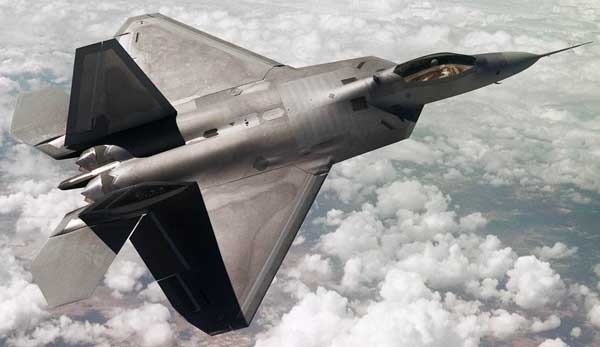
Flight testing of the ATFs began at 7.15 am Pacific Daylight Time, 27 August 1990 when Northrop test pilot Paul Metz lifted the first YF-23 off from Edwards AFB, California, at the beginning of a successful first flight. Powered by P&W YFII9s, 87-800 climbed to 7620 m (25,000 ft) during the flight and landed after 50 minutes airborne. The second YF-23, 87-801, flew on GE YF12O power shortly after, at the beginning of a highly successful flight test program.
During this program, the two YF-23s logged 65 hours on 50 missions, flown by one Northrop, one McDonnell Douglas and two Air Force pilots. A speed of Mach 1.8 and an altitude of 15340 m (50,000 ft) were achieved. The all-important super cruise' - the ability to fly sustained supersonic flight without afterburner - was demonstrated with flights up to Mach 1.43, although the top 'super cruise' speed remained classified. In flight refueling was introduced at an early stage in the program.
Due to delays associated with its YF12O engines, the first Lockheed/Boeing/General Dynamics YF-22 (N22YF) had to wait until 29 September before it could fly. Lockheed pilot Dave Ferguson had a further delay at the end of the runway while ground telemetry equipment was repaired, so when he eventually took off from the factory at Palmdale, California, only enough fuel for a short flight to Edwards AFB was possible, this accomplished with undercarriage down. On its ninth flight, the aircraft achieved super cruise at Mach 1.23. The second YF119-powered YF-22 joined the first, and after a few minor hitches concerning gear retraction, hydraulic leaks and other problems, the two embarked on a most aggressive flight test program in order to prepare enough flight data for the end-of-year proposal deadline. The second aircraft carried the registration N22YX, both YF-22s requiring civil registrations to overcome problems associated with their delivery flights from Palmdale to Edwards.
Once again, YF-22s demonstrated inflight-refuelling at an early stage. The first weapons launch by an ATF was performed by General Dynamics pilot Jon Beesley, who fired an inert AIM-9M Sidewinder over the China Lake Naval Weapons Center range. Later Lockheed pilot Tom Morgenfeld fired an AIM-120 AMRAAM from the YF-22 on 20 December over the Pacific Missile Test Center range at Point Mugu. Late on in the flight test program a YF-22 surpassed Mach 2 with the use of afterburner. As far as is known, the YF-23 program did not include missile launches as this was not required by the USAF's DemNal needs.
As has become clear during the DemNal phase, what ATF offers the US Air Force is a most significant upgrade of fighter capabilities in every department. Performance from the engine/airframe design offers exceptional agility and sustained turn performance, allied to previously unheard-of high speed cruise and acceleration figures. Key areas addressed by the design teams are reliability and maintenance. ATF offers much quicker turn-round times between missions than current generation fighters, while maintenance requirements are drastically cut by the use of advanced materials and vastly reduced numbers of components.
Another extremely important area of ATF advances is the avionics and weapon systems. Comprehensive electronic countermeasures are integrated into the overall system, which for the first time uses common processors for differing systems, allowing great system flexibility, redundancy and ease of replacement. In addition to the ground prototype for the avionics system, both ATF teams produced airborne test vehicles for key components of the system. Boeing provided the prototype 757 for integration of the YF-22's equipment, while the Northrop/McDonnell Douglas team used a Westinghouse BAG 1-11.
Principal among the components are new radars, developed to present minimal returns to a passive detection system, allowing the ATF to use its radar more freely in air combat without risking detection of the aircraft itself. Processing of data is significantly improved compared with current generation fighters, allowing swift interpretation and response to threats.
While these mission considerations were paramount, a requirement of the US Air Force was for an extremely stealthy aircraft. Central to the ATF's projected effectiveness is its ability to operate undetected. Stealth properties allow the ATF to approach its target much closer before it is detected, and therefore increase the probability of scoring a kill. The need for stealth has played a great part m defining the shapes of the fighters. Combining the need for stealth with the other operational considerations has been one of the greatest challenges in aviation design in recent years, and would not be possible without the aid of flyby-wire control systems and 3-D computer design.
Comparing the two ATF designs highlights different design configurations. While exact performances remain classified, analysis of the outward appearances would suggest that the YF-23 is stealthier and probably faster, while the YF-22 is more manoeuvrable. Certainly the inclusion in the Lockheed design of thrust-vectoring has given it an edge in the latter department. Northrop's design is more tailored to an intercept role, whereas the YF-22 can be regarded more as a fighter.
Different approaches to design are apparent. Northrop appears to have created a sophisticated stealth design (incorporating many of the features of the B-2 bomber) into which have been grafted the operational requirements of the fighter mission, while Lockheed have begun with a fighter design, and then integrated low observable features.
From what can be gleaned from publicly released information, both flight test programs proceeded exceptionally well - Lockheed being able to recapture any lost ground at the start of the program with an aggressive flight test schedule. Northrop pursued a more measured but no less successful program which highlighted the reliability of their design.
As both aircraft appear to have performed exceptionally, the Air Force's decision will hinge as much on other considerations as the individual merits of each design. Certainly cost will be a factor, as might political considerations. Without doubt combat reports from the Gulf War against Iraq will help point the way. However, the bottom line is that the Air Force has to make the choice as to whether it wants a fighter or an interceptor.
Naval interest
Closely watching the ATF program is the US Navy, which is considering the ATF design for an F-14 Tomcat replacement, suitably navalized as the NATF (Naval Advanced Tactical Fighter). Unlike the F-16/F-17 competition, it seems highly unlikely that one competitor will win the Air Force order and the other the Navy contract. Just as ATF is facing competition from advanced F-15 derivatives, so Grumman is pushing new Tomcat variants as a much cheaper alternative to NATF.
Following the award of an FSD contract, the winning ATF design faces an uphill struggle for funding, although again the war in the Gulf may ease matters considerably in this area. ProATF politicians will be quick to point out that Allied air superiority in the conflict was achieved so successfully chiefly by the use of high-technology warplanes, and that the United States should not slip behind again as it had done with the MiG-29/Su-27 generation. The US Air Force requirement is for 750 aircraft to replace its active-duty fleet of F-15s.
In service the ATF will provide a rapidly deployable asset that can achieve air superiority against any opposition. Initial purchase costs may be high, but the ATF's advances in materials, systems and construction will dramatically cut maintenance costs. More importantly, its performance, stealth properties and kill-capability will maintain the US fighter as the best in the world. As the Commander of Air Force Systems Command, General Ronald W. Yates, put it while introducing the ATF and B-2 bomber, "These aircraft are not an evolution, they are a revolution."
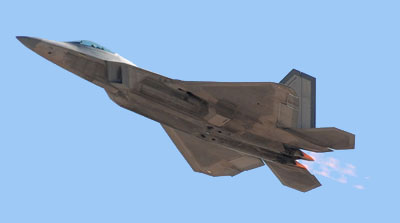 |
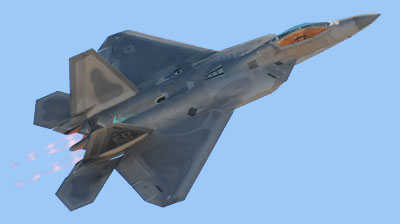 |
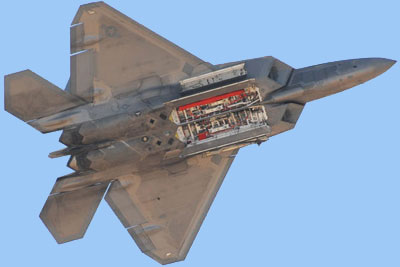 |
 |
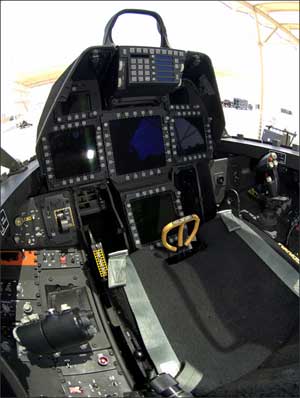 |
Lockheed F-22 Raptor Cockpit. |
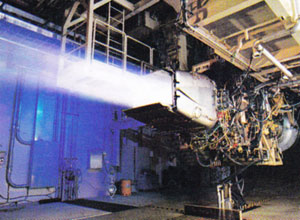 |
Lockheed F-22 Raptor test firing of the jet engines. |
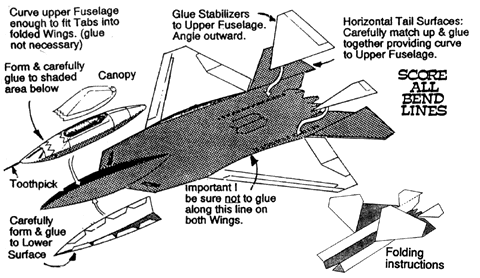
Specifications for the Lockheed/Martin/Boeing F-22 Raptor
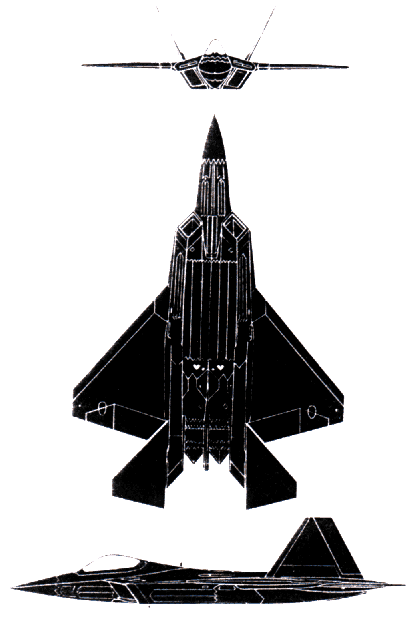 |
Length: 62 ft 1 in
|
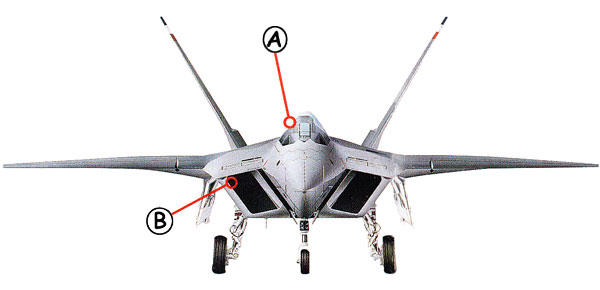 |
|
| A: No matter how high the technology, there will be occasions when air combat depends on the pilot's vision. | B: The diamond-shaped intakes follow the alignment of other surfaces, while the "S"-shaped trunk shields the highly reflective engine compressor blades from prying enemy radar. |
 |
|||
| A: The F-22's advanced cockpit is the manned end of the most advanced fighter avionics system ever built. Flight control, engines, radar, weapons and countermeasures will all be fully integrated and computer-controlled. | B: The YF-22 is equipped with a Westinghouse LP|-low probability of intercept-radar unit that has very long range, but is difficult for an enemy to detect. | C: The F-22 is an air superiority fighter. For maximum stealth it will carry its missiles in bays in the side of and under the fuselage. | D: Power is provided by a pair of Pratt & Whitney F1 19 low-bypass turbofans.They are immensely powerful and also very efficient, allowing the F-22 to cruise supersonically without afterburning. |
